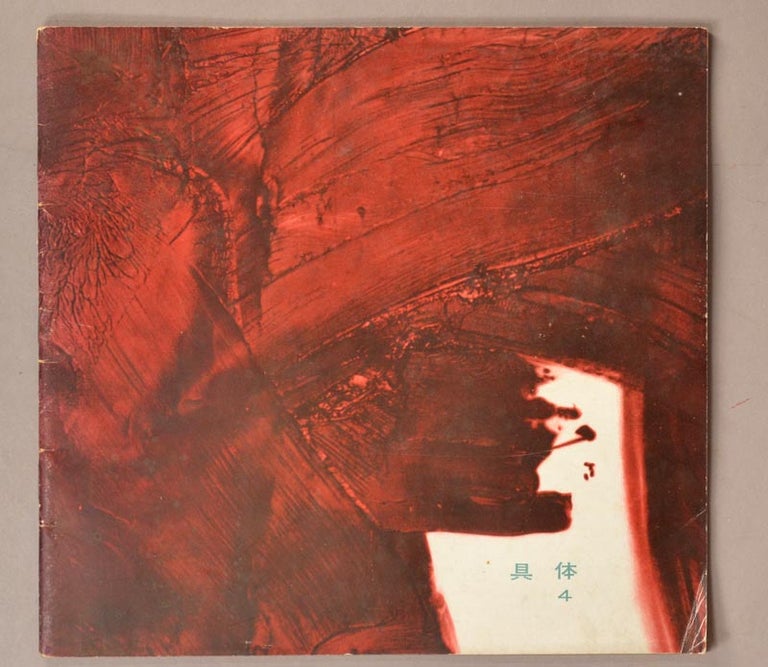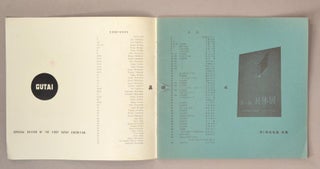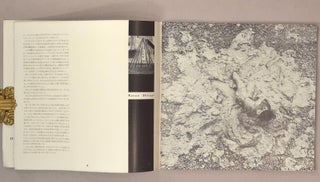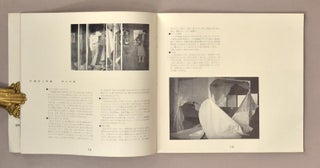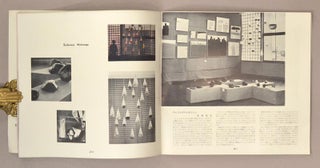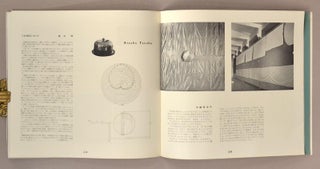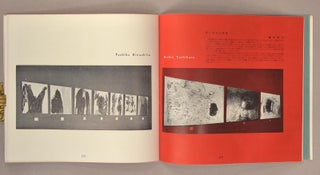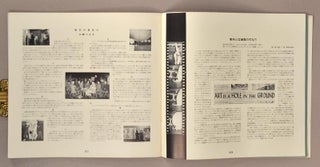Gutai 4 具体 4 - 第一回具体展 Special Edition of The 1st Gutai Art Exhibition. Gutai Henshū I-inkai 具体編集委員会
Item #90969
Gutai 4 具体 4 - 第一回具体展 Special Edition of The 1st Gutai Art Exhibition. Gutai Henshū I-inkai 具体編集委員会, publisher. Nishinomiya. July 1, 1956. 24.5 x 25.7 cm magazine with dark red wrappers decorated with an image of abstract art. 34 pages of black and white photographic images of artworks, from the 1st Gutai Art Exhibition held at Foster Hall in Tokyo in 1955. All are identified with artists' names. The avant garde artists whose work was included in the exhibition are all Japanese. The Table of Contents in English on the inside front cover lists the artists’ names and the first page has the Contents in Japanese, along with an image of the magazine poster and a small triangular cut design, on green, heavy paper. 8 x 11cm errata in Japanese text is laid in.
The essay “On the First Gutai-ten” by the well-known Gutai artist and leader Yoshihara Jirō 吉原次郎 is translated in English on page 2 and in Japanese on the following page. There are photo images with essays on Kazuo Shiraga, showing him rolling on the ground and throwing his mud-like material as well as essays on Saburō Murakami with photo images of his artwork in situ. The following pages continue with numerous black and white photo images, and five in color, and essays in Japanese text featuring avant garde Gutai artists and their works in gallery spaces and on their own. Page 33 features an essay by M/Sgt I. G. Edmonds that is translated into Japanese from English, where it appeared in Pacific Stars and Stripes titled, “Art is a Hole in the Ground.” The final, unnumbered page is also in heavy green paper and lists the Gutai members with addresses in Japanese on one side and an Itō Eishinsha sponsor advertisement on the other.
Gutai was a radical post-war art movement that preceded performance art in the US by a decade. The Gutai Art Association ( Gutai Bijutsu Kyokai) or Gutai Group was formed in 1954 by Yoshihara and Shimamoto Shozo (1928 - 2013) and was active until 1972. The physical nature of their art (gutai roughly translates to "embodiment" or "the concrete") resulted in kinetic paintings, 3-dimensional sculptures and performances. Audiences came to expect the unexpected. A Gutai Group artist might burst through hanging sheets of paper, paint with his feet while swinging on ropes or wrestle with the paints directly on the canvas, pushing the boundaries of the avant-garde Mavo movement that preceded it. At times the audience was encouraged to join in and create the art with markers on an unfinished canvas or buttons that chimed musical notes.
The Gutai magazine and subsequent PINAKOTHEK catalogs, were an important method of recording the group's art and concepts and extending to audiences abroad. One of those whom the magazine reached was Michel Tapié, a critic and collector. Tapié was a supporter of what he called "L'art informel" (Art Informel); encompassing international art that transcended what was then categorized as modern. He was a great promoter of The Gutai Group, and it was believed he found them through the GUTAI periodical.
Rubbing to covers, the front lower cover is creased.
Price: $3,000.00

